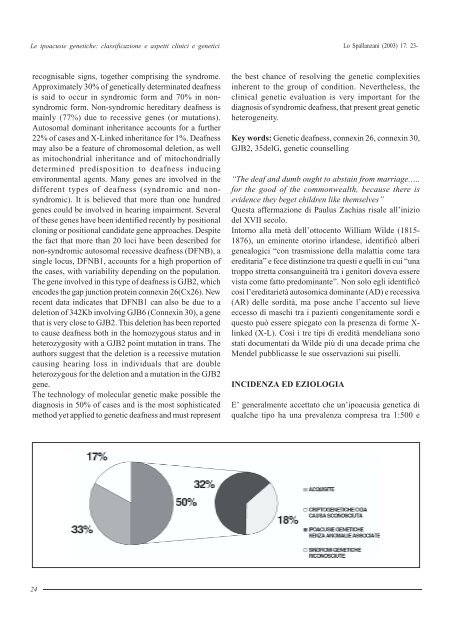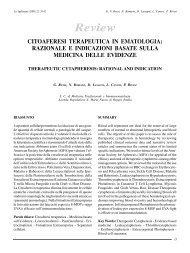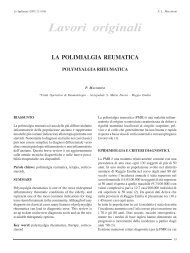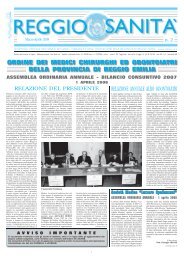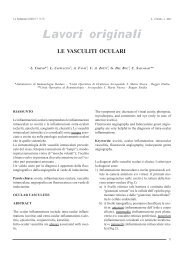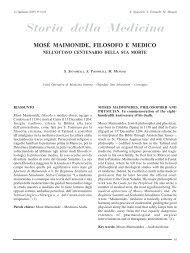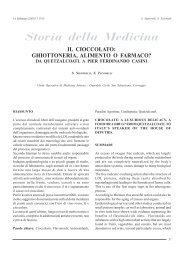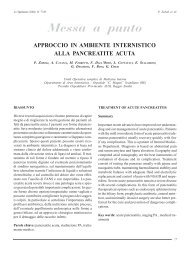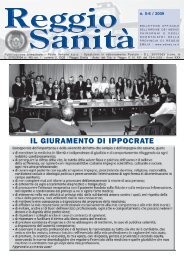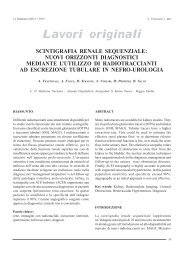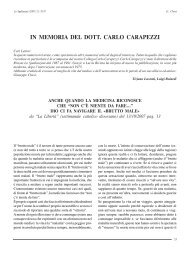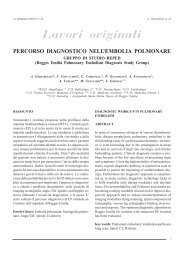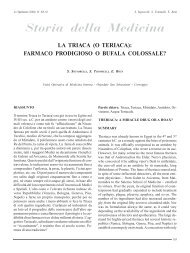le ipoacusie genetiche
le ipoacusie genetiche
le ipoacusie genetiche
Create successful ePaper yourself
Turn your PDF publications into a flip-book with our unique Google optimized e-Paper software.
Le <strong>ipoacusie</strong> <strong>genetiche</strong>: classificazione e aspetti clinici e genetici Lo Spallanzani (2003) 17: 23-<br />
recognisab<strong>le</strong> signs, together comprising the syndrome.<br />
Approximately 30% of genetically determinated deafness<br />
is said to occur in syndromic form and 70% in nonsyndromic<br />
form. Non-syndromic hereditary deafness is<br />
mainly (77%) due to recessive genes (or mutations).<br />
Autosomal dominant inheritance accounts for a further<br />
22% of cases and X-Linked inheritance for 1%. Deafness<br />
may also be a feature of chromosomal de<strong>le</strong>tion, as well<br />
as mitochondrial inheritance and of mitochondrially<br />
determined predisposition to deafness inducing<br />
environmental agents. Many genes are involved in the<br />
different types of deafness (syndromic and nonsyndromic).<br />
It is believed that more than one hundred<br />
genes could be involved in hearing impairment. Several<br />
of these genes have been identified recently by positional<br />
cloning or positional candidate gene approaches. Despite<br />
the fact that more than 20 loci have been described for<br />
non-syndromic autosomal recessive deafness (DFNB), a<br />
sing<strong>le</strong> locus, DFNB1, accounts for a high proportion of<br />
the cases, with variability depending on the population.<br />
The gene involved in this type of deafness is GJB2, which<br />
encodes the gap junction protein connexin 26(Cx26). New<br />
recent data indicates that DFNB1 can also be due to a<br />
de<strong>le</strong>tion of 342Kb involving GJB6 (Connexin 30), a gene<br />
that is very close to GJB2. This de<strong>le</strong>tion has been reported<br />
to cause deafness both in the homozygous status and in<br />
heterozygosity with a GJB2 point mutation in trans. The<br />
authors suggest that the de<strong>le</strong>tion is a recessive mutation<br />
causing hearing loss in individuals that are doub<strong>le</strong><br />
heterozygous for the de<strong>le</strong>tion and a mutation in the GJB2<br />
gene.<br />
The technology of mo<strong>le</strong>cular genetic make possib<strong>le</strong> the<br />
diagnosis in 50% of cases and is the most sophisticated<br />
method yet applied to genetic deafness and must represent<br />
24<br />
the best chance of resolving the genetic comp<strong>le</strong>xities<br />
inherent to the group of condition. Neverthe<strong>le</strong>ss, the<br />
clinical genetic evaluation is very important for the<br />
diagnosis of syndromic deafness, that present great genetic<br />
heterogeneity.<br />
Key words: Genetic deafness, connexin 26, connexin 30,<br />
GJB2, 35delG, genetic counselling<br />
“The deaf and dumb ought to abstain from marriage…..<br />
for the good of the commonwealth, because there is<br />
evidence they beget children like themselves”<br />
Questa affermazione di Paulus Zachias risa<strong>le</strong> all’inizio<br />
del XVII secolo.<br />
Intorno alla metà dell’ottocento William Wilde (1815-<br />
1876), un eminente otorino irlandese, identificò alberi<br />
genealogici “con trasmissione della malattia come tara<br />
ereditaria” e fece distinzione tra questi e quelli in cui “una<br />
troppo stretta consanguineità tra i genitori doveva essere<br />
vista come fatto predominante”. Non solo egli identificò<br />
così l’ereditarietà autosomica dominante (AD) e recessiva<br />
(AR) del<strong>le</strong> sordità, ma pose anche l’accento sul lieve<br />
eccesso di maschi tra i pazienti congenitamente sordi e<br />
questo può essere spiegato con la presenza di forme Xlinked<br />
(X-L). Così i tre tipi di eredità mendeliana sono<br />
stati documentati da Wilde più di una decade prima che<br />
Mendel pubblicasse <strong>le</strong> sue osservazioni sui piselli.<br />
INCIDENZA ED EZIOLOGIA<br />
E’ generalmente accettato che un’ipoacusia genetica di<br />
qualche tipo ha una preva<strong>le</strong>nza compresa tra 1:500 e


